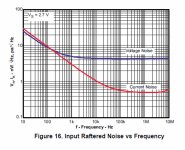Hmmm, just looked at the AD797 sheet, the OPA836 has 4 times the noise voltage amplitude - does that take it from a winner to a loser?
Frank
Frank
John and Scott (and everyone else). If you had a design brief that said you had to use one of todays dual opamps as a unity gain buffer, what devices might you consider, if the goal was putting sonics above all else. Just one or two examples you might consider worthy to work with from all todays countless offerings.
Also I read that Nelson (probably not alone in this) advocates "throwing away" some open loop gain, either by increasing the noise gain for inverting configurations or (presumably) attenuating and then amplifing for non inverting unity gain. Any thoughts on that ? I think the argument is that many devices run with 100% feedback are right on the ragged edge stability wise.
(I know there are more opamp rolling threads than you can shake a stick at but I'd really value your opinion)
Also I read that Nelson (probably not alone in this) advocates "throwing away" some open loop gain, either by increasing the noise gain for inverting configurations or (presumably) attenuating and then amplifing for non inverting unity gain. Any thoughts on that ? I think the argument is that many devices run with 100% feedback are right on the ragged edge stability wise.
(I know there are more opamp rolling threads than you can shake a stick at but I'd really value your opinion)
I wouldn't use an op amp for that use. I got 'burned' the last time I tried. Nelson is probably right.
I wouldn't use an op amp for that use. I got 'burned' the last time I tried. Nelson is probably right.
Fair enough... but if push came to shove and you had to go down the opamp route (lets say no discrete alternative due to board space) what might you use ?
Fair enough... but if push came to shove and you had to go down the opamp route (lets say no discrete alternative due to board space) what might you use ?
No need to shove and I'm not the one for listening tests but a modern JFET dual like AD8066 would do. I don't see the noise as an issue at G = 1. Those are free for me there are more choices out there.
You can do it like this. For unity gain, just leave out R3.Also I read that Nelson (probably not alone in this) advocates "throwing away" some open loop gain, either by increasing the noise gain for inverting configurations or (presumably) attenuating and then amplifing for non inverting unity gain. Any thoughts on that ?
Attachments
You can do it like this. For unity gain, just leave out R3.
This is the set-up specsheets advertise to use in order to increase distortion of opamps because otherwise with standard equipment it would be impossible to measure it.
If this is indeed used by some for audiophile effects, it might provide interesting insight in human preference.
Last edited:
No need to shove and I'm not the one for listening tests but a modern JFET dual like AD8066 would do. I don't see the noise as an issue at G = 1. Those are free for me there are more choices out there.
Thanks Scott, so AD8066 it is for your choice. Quite a high speed device for audio is that... OK, I was just curious what you and John would consider working with. John has abstained 😀
You can do it like this. For unity gain, just leave out R3.
Excellent. I never thought of that configuration for some reason.
how much current drive do you need Mooly? the OPA1642 is pretty excellent
Never tried that one, only the OPA2134 which I was quite happy with. Current drive ! That is an important factor (possibly) depending on whether I go down a low impedance route (its a tone control stage based on D Selfs precision preamp)
dual opamps
No good. Two channels almost always differ a bit. And crosstalk is not infinite.
how much current drive do you need Mooly? the OPA1642 is pretty excellent
It is not. OPA827 and ADA4627 are both much better (my private measurements).
No good. Two channels almost always differ a bit. And crosstalk is not infinite.
Would that be a real problem in practice do you think ? A practical PCB layout for something like this might only achieve 70/80db separation at a guess. I think trying to keep crosstalk equal, L to R and R to L is important though.
What the matter ?
Main problem is difference in distortion of two channels of dual opamps. And they behave worse than single opamps of same type. Again - my private files.
- Status
- Not open for further replies.
- Home
- Member Areas
- The Lounge
- John Curl's Blowtorch preamplifier part II

